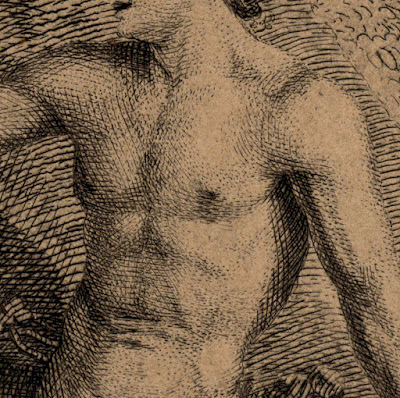Johann Elias Ridinger (aka Johann Elias Riedinger)
(1698–1767)
“Adam names the
Animals” (Genesis 2. 19. 20: “The man gave names to all livestock, and to the
birds of the sky, and to every animal of the field; but for man there was not
found a helper suitable for him.” [Word English Bible]), 1745, published in Augsburg
1767, from the series, “Das Paradies oder die Schöpfung und der Sündenfall des
ersten Menschenpaares (Paradise: the Creation, the fall of man and the expulsion
of the first couple of man“)
The British
Museum offers the following description of this series and its publication:
“A bound
portfolio containing twelve prints illustrating Adam and Eve in Paradise; the creation
and fall of man. c.1730–60 Etching with some engraving; in the original blue
wrapper”
Etching and
engraving on heavy brown paper.
Size: (sheet) 43.5
x 63.5 cm; (plate) 39 x 53.5 cm; (image borderline) 35 x 52 cm
Each sheet in
the Paradise series is lettered with bible quote inscribed in German, French
and Latin and lettered with production and publication detail: “Ioh. Elias Ridinger
invenit fec et excud. A V.
Thienemann 1856
807-181 (Georg Thienemann 1856, “Johann Elias Ridinger, Maler und Kupferstecher,
nach Seinem Leben un Wirken”, Leipzig, Rudolph Weigel); Nagler 6
Condition: exceptionally
rare and near faultless impression printed on brown paper with margins as
published. There are remnants of mounting tape (verso)
This print has
been sold along with the other plates from the Paradise series
(which I will be
posting soon)
This print shows
the very first sunrise as described in the Old Testament with Adam broadly
gesturing to the rich diversity of animals filling the Garden of Eden.
Ridinger
clearly wanted this and the other plates from his “Paradise” series to be an
ultimate statement about God’s handiwork; after all the conspicuous consumption of time committed to the plate is plain to see. Ridinger certainly ensured that every square inch of this particular plate
is “filled to the brim” or, to borrow another phrase, “packed to the rafters”
with every critter imaginable. Not only do they seem to struggle to be in our
view but many of them interact with each other with a slight hint of territory
marking.
Leaving aside
the shameful idea proposed to me that these animals are slightly eroticised and
question Adam’s interest in them—mindful that Eve has not set foot in the
garden at this point in the story—my interest centres on the birds in the sky.
My interest in these birds is that at the time when this print was being
executed the world was beginning to hear about the Birds of Paradise in New
Guinea. More exciting than this, a marvellous folklore had arisen that such
birds never landed but spent their lives perpetually flying in a sky paradise
with their eggs and young ones tucked safely in their feathers.
Regarding the
significance of this print and the others of the series, an interesting website
that discusses Ridinger’s plates is “Niemeyer’s AHA! Events” (December
2013) which offers the following insight into Ridinger’s aim:
“‘… to show the
manifold zoological manifestations, the presentation of carefully painted
native and exotic animals’, the latter he had become acquainted with as court
painter of emperor Rudolph II, at once setting himself apart from the majority
of the Dutch colleagues who had to confine themselves to domestic animals.”
(http://aha.luederhniemeyer.com/aha1312e.php;
the in text quote may be from Kurt J. Müllenmeister’s “Roelant Savery” / Die
Gemälde. 1988)









No comments:
Post a Comment
Please let me know your thoughts, advice about inaccuracies (including typos) and additional information that you would like to add to any post.